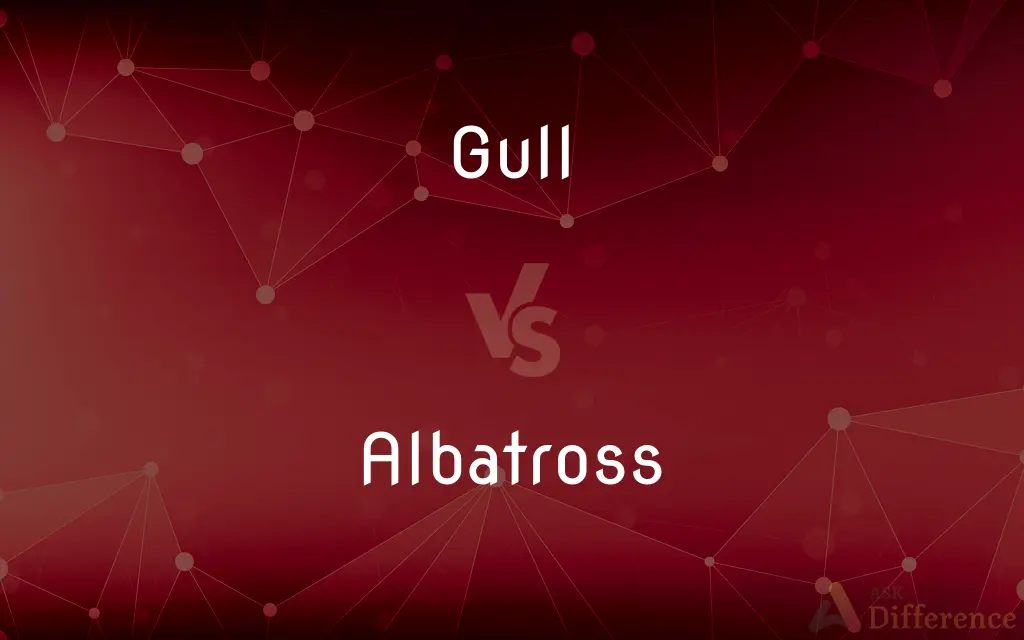Gull vs. Albatross — What's the Difference?
By Fiza Rafique & Urooj Arif — Updated on April 16, 2024
Gulls are generally smaller, adaptable seabirds known for varied diets and behaviors, often found near coasts and inland; albatrosses are larger, specialized for long-distance oceanic flights with narrower diets, primarily found over open seas.

Difference Between Gull and Albatross
Table of Contents
ADVERTISEMENT
Key Differences
Gulls are medium-sized birds that exhibit great adaptability, thriving in varied environments from beaches to cities, feeding on anything from fish to human waste. Conversely, albatrosses are among the largest flying birds, specializing in living almost exclusively over ocean waters, with a diet predominantly consisting of squid and fish caught during flight.
Gulls have a wingspan that typically ranges from about 40 to 75 cm, which facilitates both dynamic aerial maneuvers and walking on land. On the other hand, albatrosses have much larger wingspans, often exceeding 3 meters, enabling them to glide over the ocean for hours or even days with minimal energy expenditure.
While gulls are known for their opportunistic feeding habits, easily switching between natural food sources and scavenging, albatrosses rely on their ability to skim the ocean's surface while flying to catch their prey, making them less versatile in feeding behavior.
The breeding habits of gulls are quite flexible, with many species nesting in large colonies on the ground or roofs in urban areas. In contrast, albatrosses typically breed on isolated islands, laying a single egg every one or two years, and are known for their long-term monogamous relationships.
Socially, gulls are often seen in large, noisy groups and are known for their aggressive scavenging behavior. Albatrosses, however, spend most of their lives in solitude at sea, coming together with others only during the breeding season and known for their quieter demeanor.
ADVERTISEMENT
Comparison Chart
Size
Smaller (40-75 cm wingspan)
Larger (up to 3.4 meters wingspan)
Habitat
Coastal and inland areas, urban environments
Primarily open ocean
Diet
Varied: fish, insects, waste, small animals
Specialized: mainly squid and fish
Breeding
Colonies; multiple eggs per season
Isolated islands; one egg every 1-2 years
Social Behavior
Often in large, noisy groups
Solitary at sea, social during breeding
Compare with Definitions
Gull
A widespread family of medium-sized seabirds, adaptable to diverse environments.
Gulls are often seen scavenging at beaches.
Albatross
Forms long-term monogamous pairs and breeds on remote islands.
Albatross couples often reunite at the same breeding site each season.
Gull
Known for their varied diet and intelligence.
Gulls can open shellfish by dropping them from heights.
Albatross
Among the largest of flying birds, noted for their enormous wingspans.
Albatrosses can glide over the ocean without flapping for hours.
Gull
Exhibits complex social behaviors and vocalizations.
Gulls communicate with various calls to protect their territories.
Albatross
Live predominantly over open seas, rarely landing except to breed.
Albatrosses spend most of their life flying over oceans.
Gull
Commonly found in both coastal and urban areas.
Gulls are frequent visitors in city parks.
Albatross
Diet consists mainly of squid and fish, caught during flight.
Albatrosses skim the ocean surface to catch their prey.
Gull
Capable of both swimming and walking efficiently.
Gulls gather in large groups on shorelines.
Albatross
Known for their long-distance flying capabilities.
Albatrosses can travel thousands of miles in a single journey.
Gull
Gulls, or colloquially seagulls, are seabirds of the family Laridae in the suborder Lari. They are most closely related to the terns (family Sternidae) and only distantly related to auks, skimmers and even more distantly to waders.
Albatross
Albatrosses, of the biological family Diomedeidae, are large seabirds related to the procellariids, storm petrels, and diving petrels in the order Procellariiformes (the tubenoses). They range widely in the Southern Ocean and the North Pacific.
Gull
Any of various chiefly coastal seabirds of the family Laridae, having long wings, webbed feet, a thick, slightly hooked beak, and usually gray and white plumage.
Albatross
Any of several large web-footed birds constituting the family Diomedeidae, chiefly of the oceans of the Southern Hemisphere, and having a hooked beak and long narrow wings.
Gull
A person who is easily tricked or cheated; a dupe.
Albatross
A source of worry or distress.
Gull
To deceive or cheat.
Albatross
An obstacle to success.
Gull
A seabird of the genus Larus or of the family Laridae.
Albatross
Any of various large seabirds of the family Diomedeidae ranging widely in the Southern Ocean and the North Pacific and having a hooked beak and long narrow wings.
Gull
Any of various pierid butterflies of the genus Cepora.
Albatross
Any of various African and Asian pierid butterflies of the genus Appias. Some species of this genus are also known as puffins.
Gull
(slang) A cheating trick; a fraud.
Albatross
(golf) A double eagle, or three under par on any one hole, except a par 3 hole.
Gull
One easily cheated; a dupe.
Albatross
(figurative) A long-term impediment, burden, or curse.
Gull
A swindler or trickster.
Albatross
A web-footed bird, of the genus Diomedea, of which there are several species. They are the largest of sea birds, capable of long-continued flight, and are often seen at great distances from the land. They are found chiefly in the southern hemisphere.
Gull
To deceive or cheat.
Albatross
(figurative) something that hinders or handicaps;
She was an albatross around his neck
Gull
To mislead.
Albatross
Large web-footed birds of the southern hemisphere having long narrow wings; noted for powerful gliding flight
Gull
To trick and defraud.
Gull
To deceive; to cheat; to mislead; to trick; to defraud.
The rulgar, gulled into rebellion, armed.
I'm not gulling him for the emperor's service.
Gull
A cheating or cheat; trick; fraud.
Gull
One easily cheated; a dupe.
Gull
One of many species of long-winged sea birds of the genus Larus and allied genera.
Gull
A person who is gullible and easy to take advantage of
Gull
Mostly white aquatic bird having long pointed wings and short legs
Gull
Make a fool or dupe of
Gull
Fool or hoax;
The immigrant was duped because he trusted everyone
You can't fool me!
Common Curiosities
What is the main threat to gulls in urban areas?
In urban areas, gulls face threats from pollution and habitat loss.
Can albatrosses walk on land?
Albatrosses are capable of walking but are much more adapted to life in the air.
How do gulls adapt to different environments?
Gulls adapt by exploiting a wide range of food sources and nesting in diverse locations.
Are gulls found only near the ocean?
No, gulls are versatile and can be found in many inland and urban areas as well.
How do gulls communicate?
Gulls use a variety of calls and body movements to communicate, especially in social and defensive contexts.
How long can an albatross live?
Albatrosses can live for over 60 years in some cases.
How do albatrosses navigate such long distances?
Albatrosses use a combination of stellar and magnetic cues to navigate the open oceans.
Do albatrosses interact with humans?
Albatrosses generally avoid human contact unless nesting on islands visited by people.
Are albatrosses important to island ecosystems?
Yes, as top predators and as vectors for nutrient distribution, they play key roles in their ecosystems.
What role do albatrosses play in maritime folklore?
Albatrosses are often seen as omens of good or bad luck at sea.
How do conservation efforts support albatross populations?
Efforts include protecting nesting sites and implementing bycatch reduction techniques in fisheries.
What are the conservation statuses of albatrosses?
Many albatross species are considered endangered or threatened, mainly due to longline fishing practices.
Do albatrosses have natural predators?
Adult albatrosses have few natural predators, but eggs and chicks are vulnerable to birds and mammals.
Can gulls be trained?
Gulls are intelligent birds and can learn complex behaviors, but they are not typically trained by humans.
What are the breeding habits of gulls?
Gulls typically nest in large colonies and can produce several chicks each season.
Share Your Discovery

Previous Comparison
Cyclothymia vs. Dysthymia
Next Comparison
Amount vs. CountAuthor Spotlight
Written by
Fiza RafiqueFiza Rafique is a skilled content writer at AskDifference.com, where she meticulously refines and enhances written pieces. Drawing from her vast editorial expertise, Fiza ensures clarity, accuracy, and precision in every article. Passionate about language, she continually seeks to elevate the quality of content for readers worldwide.
Co-written by
Urooj ArifUrooj is a skilled content writer at Ask Difference, known for her exceptional ability to simplify complex topics into engaging and informative content. With a passion for research and a flair for clear, concise writing, she consistently delivers articles that resonate with our diverse audience.














































